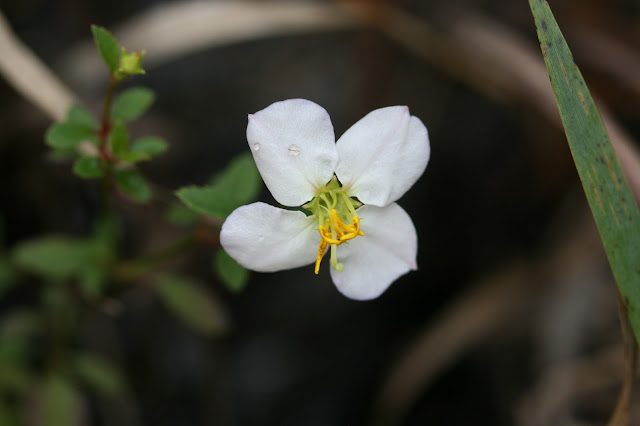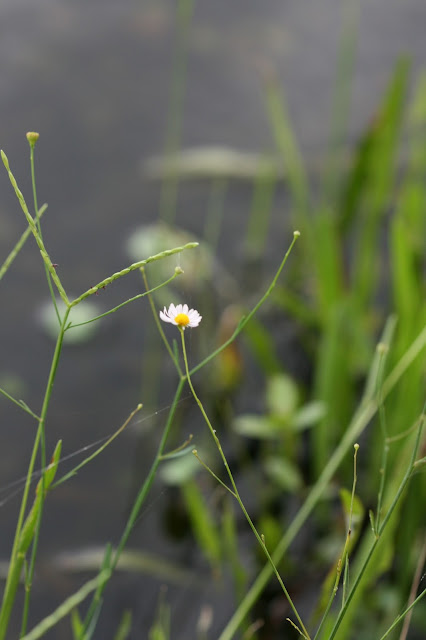Apalachicola meadowbeauty (Rhexia parviflora) is an especially rare member of this common genus and listed as a state endangered species. Found in Florida only in the central and western Panhandle counties, it also has a very limited distribution in parts of adjacent Georgia and Alabama. Throughout its limited range, it is resident to moist soil habitats such as seepage slopes, depression marshes, and the upper edges of cypress domes. The plants photographed above were found growing in about 1 inch of water at the edge of an isolated cypress dome in the Apalachicola National Forest in mid-August.
Apalachicola meadowbeauty is a perennial herb that dies back to the ground in winter. It emerges in spring, but remains small and can go largely unnoticed in the understory vegetation until it blooms in summer. Few plants reach a mature height of 16 inches; most are less than 1 foot tall. The stems are square and somewhat "hairy", while the leaves are 1/2-1 inch long, oval in shape and attached to the main stem by a petiole. No other meadowbeauty in Florida combines this feature with white petals. The common pale meadow beauty (R. mariana) is only sometimes white, does not have leaf stalks, and normally occurs in drier habitats.
The flowers are composed of four bright rounded white petals and are normally less than 1 inch across. The reproductive parts are bright yellow and the anthers curl slightly backward. The blooms mostly attract the attention of bees.
Apalachicola meadowbeauty is one of many examples of how unique the state's flora is. This is a difficult plant to locate and requires some sleuthing in wet habitats during the summer to locate it. If you do, simply admire it for its subtle beauty. Do not attempt to collect any portion of it for any purpose without permits. This is not a specimen for use in a home landscape. There are many, more common species better for that purpose.
Sunday, November 22, 2015
Fringed meadowbeauty - Rhexia petiolata
Fringed meadow beauty (Rhexia petiolata) is a common component of wet open habitats throughout much of Florida (except the very lowest tiers of counties). It also occurs in much of the Southeast Coastal Plain from Texas to Maryland. It can be easily confused with the also-common Nuttall's meadow beauty (R. nuttallii), with which it overlaps significantly in geographic range, but fringed meadow beauty has no hairs on the outside of its rounded urn-shaped seed capsules while Nuttall's is conspicuously covered by glandular hairs.
This, like other members of the genus, are perennial herbs that die back in winter. Stems arise from the hardened base in spring and reach a mature height of 6 inches to 2 1/2 feet. The plants photographed above in a pitcher plant bog in Apalachicola National Forest in mid-August were on the taller end of the height spectrum for this species. The leaves are oval, clasp the stem and are less than 1 inch long. Noticeable hairs occur on the margins.
Flowering lasts from June until early fall. The 4-petal pink flowers are borne singly or in small clusters at the end of the stems. The blooms are about 1-inch across and nearly indistinguishable from Nuttall's meadow beauty. The petals tend to have wavy margins and curl upwards. Most other meadow beauties hold their flowers at 90-degree angles to the ground and have more-flattened petals,
Fringed meadow beauty is not currently grown commercially in Florida by any nursery affiliated with FANN- the Florida Association of Native Nurseries. Its somewhat demure aesthetics make it unlikely to be added in the future.
Lance-leaf Rose-gentian - Sabatia difformis
Lance-leaf rose-gentian (Sabatia difformis) is a perennial member of this genus and resident to wet open habitats throughout much of central and north Florida. It also is resident throughout much of the Southeast Coastal Plain from Alabama to New Jersey.
This is a unique member of an interesting genus; its species name, difformis, is derived from its atypical form, and it is distinctive enough not to be confused with other rose-gentians. Lance-leaf rose-gentian dies back to the ground in winter, but reaches a mature height of about 3 feet by late spring. The leaves are only about 1 inch long, narrowly lanceolate, and tend to point upwards. They also lack a petiole (the leaf stem) and strongly clasp the main stem. The basal leaves are normally absent (or underwater) by blooming season.
A multi-branched flower stalk is produced atop the main stem and may be 6 inches across. Clusters of bright white, 5-petal flowers open from May through late summer. Each petal is nearly 1/2 inch long, making the mature inflorescence quite showy. They attract pollinators.
Lance-leaf rose-gentian is not grown commercially in Florida and would require specific conditions to prosper. Look for it in open marshes and bogs in summer and admire it for its simple beauty.
Doll's Daisy - Boltonia diffusa
Doll's daisy (Boltonia diffusa) is easily confused, at first glance, with the true daisies in the genus Symphyotrichum. In fact, the best way of telling the genera apart lies in looking at the seeds. Asters (and fleabanes (Erigerons) ) have coverings over the seeds that have numerous bristles while doll's daisy has very few. Doll's daisies (there are 3 species in Florida) are thinly branched perennial herbs that occur in seasonally wet habitats. They are never found far from shallow standing water. This species is the only one found statewide. It also occurs throughout much of the southern and lower Midwestern states.
Doll's daisy dies back to the ground in winter and emerges in early spring. As it suckers profusely underground, it normally occurs in colonies. It reaches a mature height of 3-5 feet tall by summer. The leaves are narrow, alternate along the stem, and are less than 1 inch long. The leaf margins are often smooth, but may have several small teeth.
Flowering occurs from summer through fall. Each bloom is 1/2 inch across, on average, and composed of numerous white to light lavender ray petals surrounding a bright yellow disk. Each is held on long stems on top of the main branches. Like all members of the daisy family, they attract pollinators.
Doll's daisy requires seasonably wet to shallowly inundated soils. As such, it is not a wildflower likely to be offered for home landscape purposes. Its small flowers and spindly stems also reduce its aesthetic qualities, but it has value in a wetland pollinator garden. To my knowledge, it is not available commercially, but could be grown from seed collected in fall.
Doll's daisy dies back to the ground in winter and emerges in early spring. As it suckers profusely underground, it normally occurs in colonies. It reaches a mature height of 3-5 feet tall by summer. The leaves are narrow, alternate along the stem, and are less than 1 inch long. The leaf margins are often smooth, but may have several small teeth.
Flowering occurs from summer through fall. Each bloom is 1/2 inch across, on average, and composed of numerous white to light lavender ray petals surrounding a bright yellow disk. Each is held on long stems on top of the main branches. Like all members of the daisy family, they attract pollinators.
Doll's daisy requires seasonably wet to shallowly inundated soils. As such, it is not a wildflower likely to be offered for home landscape purposes. Its small flowers and spindly stems also reduce its aesthetic qualities, but it has value in a wetland pollinator garden. To my knowledge, it is not available commercially, but could be grown from seed collected in fall.
Subscribe to:
Comments (Atom)












